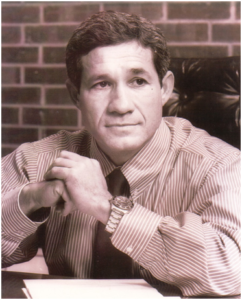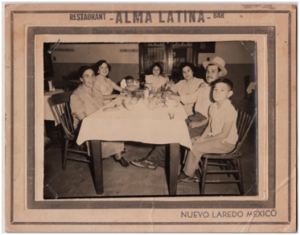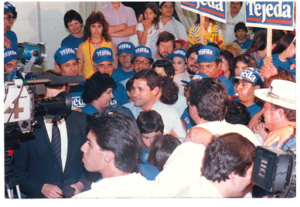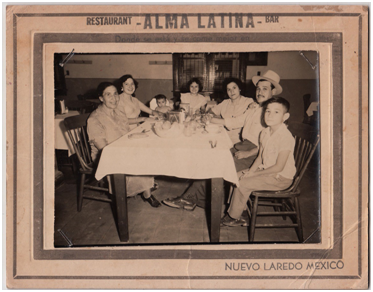 By Ricardo Romo
By Ricardo Romo
While there are fifteen parks, schools, buildings, and roads named for Southsider Frank Tejeda, few people really know his accomplishments. There are only a few scholarly studies that discuss his life and political career. Understanding Tejeda’s life and purpose contributes to a greater comprehension of San Antonio’s Southside, a large area of the nation’s seventh largest city. Before Tejeda’s entry into politics in the late 1970s, Mexican Americans and Blacks from San Antonio’s Southside lacked a strong voice for their concerns and issues.
Frank Tejeda’s ancestors came to the Southside before the American Revolution and even long before the Alamo. Tejeda’s father, Francisco Tejeda, grew up in the Losoya area not far from the current location of Southside High School. Francisco Tejeda served in the Army and was completing his service in 1941 when Pearl Harbor was attacked by Japanese forces. He married Lilia Cisneros in 1942, and he returned to Army service in 1944. He was wounded in Italy and received the Bronze
Star and Purple Heart. Two years after his return from Italy, Francisco and his wife moved to a home on Pleasanton Road in the heart of the Southside.
Francisco and Lilia Tejeda raised their family of five children in a poor community and a tough barrio for Mexican American youth. Their mom operated Lillie’s Beauty Shop where the Gonzaba Medical offices are currently located. As a disabled WWII veteran Francisco Tejeda worked at odd jobs mostly in the South- side. As a teen young Frank helped his dad in his work tending to odd jobs that demanded much and paid little. I was fortunate to know two of the younger Tejedas, Frank and Juan. I knew Juan best, meeting him when I returned to Texas in 1980 just as I began teaching his- tory at UT Austin. Juan studied at UT from 1972-1978 and is well known to conjunto music fans as the founder of Conjunto Aztlan and the Tejano Conjunto Festival.
I interviewed Juan to find out more about his brother’s experiences growing up in the Southside.
 Frank, who was born in 1945, attended St. Leo’s Catholic School from the first to eighth grade. At St. Leo’s he was an altar boy, a Boy Scout, and an outstanding second baseman on a Little League baseball team. His family took pride in Frank’s dedication to St. Leo’s education program as evidenced by his record of never
Frank, who was born in 1945, attended St. Leo’s Catholic School from the first to eighth grade. At St. Leo’s he was an altar boy, a Boy Scout, and an outstanding second baseman on a Little League baseball team. His family took pride in Frank’s dedication to St. Leo’s education program as evidenced by his record of never
missing a single day of classes.
For many Southside teens, the 1950s and 1960s were turbulent years. Prior to 1960, most Southside schools were segregated, and African American children and teens attended Black schools. Every Latino growing up in San Antonio during that era recognized that prejudice and discrimination was also often directed at them. Frank Tejeda attended Harlandale High School, which some former students of that era estimated to be 60 percent white and 40 percent Hispanic. Blacks enrolled at Harlandale after the late 1950s and early 1960s. Juan Tejeda commented that Mexican Americans felt that many of their classmates harbored prejudice against students of color. These attitudes added to social ten- sions between various ethnic and social groups.
Frank Tejeda also attended high school during the rise of Westside and Southside gangs. Mexican Americans who joined gangs did so for protection or because they thought it was cool to be rebellious. Frequent fights were considered a proper way to prove their manhood. Tejeda avoided the gang warfare, but he was rebellious and a fighter according to the interview with his younger brother Juan. When Frank Tejeda was involved in a confrontation with a school administrator during his senior year, he decided to leave Harlandale High School and join the U.S. Marine Corps. Tejeda was not quite age 18, but his parents reluctantly gave in to his desire for a new phase in his life and signed a waiver to allow him to become a Marine. Tejeda firmly believed that that the U.S. Marines might instill some discipline and help him sort out his goals in life. Tejeda began his military service in 1963 at age 17. Tejeda excelled in the Marines and was deployed to Vietnam, just two years out of high school. His promo- tion to Staff Sergeant in 1965 at age 19 made him the youngest in that rank in the U.S. Marines. Like most Americans, Tejeda likely knew very little of this East Asian country when he learned of his deployment . As many veterans would later testify, no one was prepared to fight in a country noted for its dense jungles, danger- ous river deltas, and mountainous terrain. Moreover, American combat forces arrived in Vietnam in the midst of a civil war where the enemy could reside in any of the many villages and not necessarily wear a military uniform.
Tejeda’s tour in Vietnam extended from 1965 to 1966. In 1966 he was wounded near Da Nang and received the Purple Heart and Bronze Star. He was awarded the Silver Star posthumously by President Bill Clinton. In 1967, Tejeda returned to Texas. He had earned his GED and enrolled in college courses while a Marine. Upon his return from Vietnam he enrolled at St. Mary’s University using the G.I. benefits to pay for his tuition. In the 1970s Dr. Charles Cotrell taught a popular po- litical science course that interested Tejeda and his Southside friend Ciro Rodriguez. Contrell, who later served as president of St. Mary’s has fond memories of both Tejeda and Rodriguez.
Being a Marine and a Southsider were among the two most important things about Tejeda, according to Co- trell. Frank Tejeda was one of the most focused students at St Mary’s and impressed Cotrell with his energy, his dedication, and his drive to excel. Tejeda majored in Government and earned a bachelor’s degree in 1970.
 While attending St. Mary’s University, Tejeda worked part time with several Southside community organizations. He was active with the San Antonio Neighborhood Youth Organization, (SANYO) founded by Bishop John Yanta in 1966. SANYO defined its mission as helping youth stay out of trouble and providing the skills to help them find jobs. From the mid 1960s to the time that Tejeda served in the U.S. Congress, SANYO received more than 125 million dollars for youth job training and sum- mer programs. In his campaigns Tejeda reached out to former SANYO participants and many become active in Southside political contests.
While attending St. Mary’s University, Tejeda worked part time with several Southside community organizations. He was active with the San Antonio Neighborhood Youth Organization, (SANYO) founded by Bishop John Yanta in 1966. SANYO defined its mission as helping youth stay out of trouble and providing the skills to help them find jobs. From the mid 1960s to the time that Tejeda served in the U.S. Congress, SANYO received more than 125 million dollars for youth job training and sum- mer programs. In his campaigns Tejeda reached out to former SANYO participants and many become active in Southside political contests.
Upon his graduation from St. Mary’s, Tejeda enrolled at UC Berkeley School of Law. After finishing law school in 1974, Tejeda returned to San Antonio. He passed the Texas Bar and opened a small law office in the Southside. He joined with Frank Wing, Edmundo Zaragoza, and several community activists seeking political representation for the Southside. In 1976 Tejeda was elected to a seat in the Texas House of Representa- tives. He served five sessions in the Texas House from 1977 to 1987. Some of Tejeda’s earliest support came from veterans, many of whom admired his military record in Vietnam.
In short time Tejeda became a major political force in the Southside. Tejeda also was becoming an influential political player in city politics. When Henry Cisneros decided to run for mayor, he encountered opposition in the Eloy Centeno camp. Centeno, who owned several large super markets in San Antonio, considered Cisne- ros too inexperienced for the top city post and Centeno aspired to be mayor himself.
In “Cisneros: Portrait of a New American,” authors Kemper Diehl and Jan Jarboe noted that Centeno had several major Northside San Antonio political leaders opposed to his candidacy. Diehl and Jarboe wrote: “If Centeno needed any further discouragement, the decision of Councilman Frank Wing and State Representative Frank Tejeda to support Cisneros was the final straw.” *76 Southsiders interested in greater Latino presence in state office often worked with the great political organizer, Willie Velasquez, head of Southwest Voter Registration and Education Project (SVREP). SVREP trained Southsiders to block walk for candidates and developed media campaign strategies for political can- didates. Tejeda’s masterful coalition building as well as
his commitments to veterans, teachers, and youth gave him an edge in the election to the Texas Senate in 1986. In the Texas Senate Tejeda successfully fought against pari- mutuel horse racing wagers and a state lottery system. He championed a crime victim’s bill-of- rights and sponsored bills creating the Texas Veteran Housing Assistance programs. While serving in the Texas legislature, Tejeda earned two master’s degrees–in 1980 a M.S. from Harvard University and in 1989, a LL.M
from Yale Law School.
With the creation of the new 28th U.S. Congressional district in the Southside, Tejeda easily won his first term to the U.S. Congress in 1992. In January of 1993 he was sworn is as the first ever Mexican American congress- man from South San Antonio. With his appointment to the House Armed Services and Veterans Affairs committees, Tejeda was a major defender of military bases in San Antonio. Despite his outstanding work in building coalitions to protect Kelly and Brooks Air Forces bases from Pentagon defense cutting legislation, the San Antonio bases were closed in the mid 1990s.
In 1995 Tejeda was diagnosed with cancer, and despite extensive treatment, he succumbed to the illness and passed away in 1997. His friend and U.S. Department of Housing and Urban Development (HUD) Secretary Henry Cisneros praised Tejeda for his military ser- vice, his commitment to his neighborhood, and his
advocacy for San Antonio and the American people.
Brooks Air Force Base, which was part of Tejeda’s congressional district, has since made enormous strides in bringing jobs back to the Southside. That effort will be the topic of a future article.
Our thanks to Juan Tejeda for the use of these special photos from his personal collection. Mil gracias!


Recent Comments